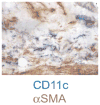Dendritic cells: novel players in fibrosis and scleroderma
- PMID: 22006170
- PMCID: PMC5815163
- DOI: 10.1007/s11926-011-0215-5
Dendritic cells: novel players in fibrosis and scleroderma
Abstract
Dendritic cells are professional antigen-presenting cells that are most studied for their function in mediating T-cell tolerance and T-cell activation. In addition, recent evidence indicates that dendritic cells can regulate the vasculature and function of fibroblast-type cells. The potential contribution of dendritic cells to scleroderma and fibrosis is not well-understood. In this article, we review recent studies as well as describe our own ongoing work that points toward a role for dendritic cells in scleroderma and fibrosis.
Conflict of interest statement
Figures


References
-
- Maricq HR, LeRoy EC. Patterns of finger capillary abnormalities in connective tissue disease by “wide-field” microscopy. Arthritis Rheum. 1973;16:619–28. - PubMed
-
- Hettema ME, Zhang D, Stienstra Y, et al. Decreased capillary permeability and capillary density in patients with systemic sclerosis using large-window sodium fluorescein videodensitometry of the ankle. Rheumatology. 2008;47:1409–12. - PubMed
-
- Ramos-Casals M, Fonollosa-Pla V, Brito-Zeron P, et al. Targeted therapy for systemic sclerosis: how close are we? Nat Rev Rheumatol. 2010;6:269–78. - PubMed
Publication types
MeSH terms
Grants and funding
LinkOut - more resources
Full Text Sources
Medical

